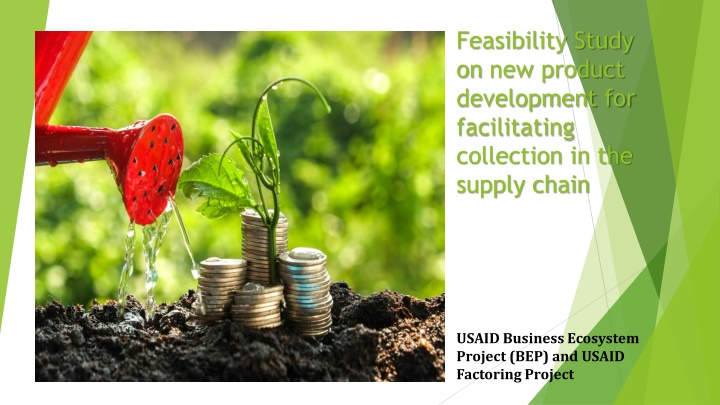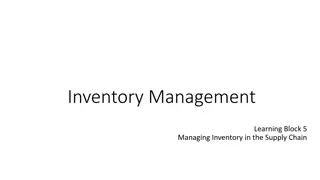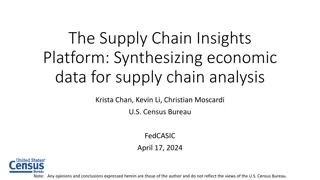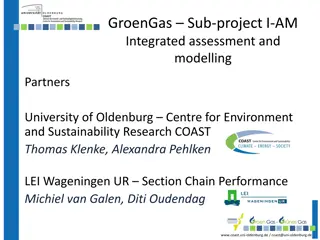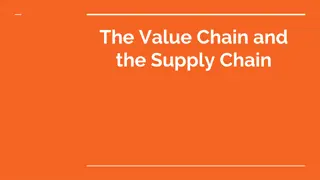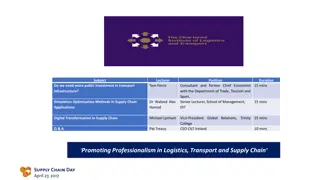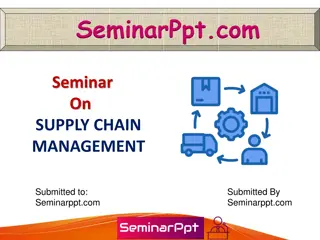Feasibility Study on New Product Development for Supply Chain Collection Enhancement
Feasibility study conducted as part of the USAID Business Ecosystem Project and USAID Factoring Project to assess the need for financial products benefiting farmers and buyers in the supply chain. Study involved leading agribusinesses and farmers in various sectors to understand payment challenges and opportunities for factoring solutions. Initial findings highlighted the size and purchasing patterns of companies, emphasizing the importance of facilitating timely payments to farmers for sustainable growth.
Uploaded on Sep 16, 2024 | 3 Views
Download Presentation

Please find below an Image/Link to download the presentation.
The content on the website is provided AS IS for your information and personal use only. It may not be sold, licensed, or shared on other websites without obtaining consent from the author.If you encounter any issues during the download, it is possible that the publisher has removed the file from their server.
You are allowed to download the files provided on this website for personal or commercial use, subject to the condition that they are used lawfully. All files are the property of their respective owners.
The content on the website is provided AS IS for your information and personal use only. It may not be sold, licensed, or shared on other websites without obtaining consent from the author.
E N D
Presentation Transcript
Feasibility Study on new product development for facilitating collection in the supply chain USAID Business Ecosystem Project (BEP) and USAID Factoring Project
Initial assumptions several large companies are leading the supply chain thus directly influencing the flow of money. The quantities offered, and the price agreed, are determine by the amount of money available at the time of transaction. Due to solvency and liquidity issues, companies buying from farmers usually differ the payment thus postponing their turnover, disrupting farmers cash flow and delaying financial activities for the following season. Financially disabled producers, while spending their accumulated capital for day-by-day activities become unable to invest and grow.
The purpose of the study To enable USAID BEP and Factoring Project to evaluate the interest for such financial products and later provide technical assistance to FIs to develop them with terms that suit both the needs of the farmers and the buyers of their produce. Targeted borrowers are food processors, exporters and other entities that purchase fresh produce from the farmers but are unable to pay them immediately.
The Scope of the Survey 40 preselected leading agribusinesses in four subsectors participated in the survey for Developing Feasibility Study: Dairy, Fresh fruits and vegetables, Agro Processing and Wine Additionally five focus groups in Strumica, Bogdanci, Stip, Negotino and Bitola with more than 50 farmers were facilitated to capture and adequately integrate input from raw materials suppliers/farmers as potential beneficiaries of factoring. The preliminary findings of the survey were presented to and discussed with several commercial Banks and financial institutions including ProCredit Bank, NLB, HALKBANK and Alliance of Microfinance organizations (MOZNOSTI, HORIZONTI, FULM and MRFP)
Findings According the number of employees (47. 5%) of the companies were small and 35% were medium sized In terms of turnover 57.5% companies of medium range of 2-10 mil, around 30% are small and 3 companies qualified as large with above 10 mil euro.
Findings On average 82.6% purchase from farmers whereas 17.4% have own production Companies usually have a smaller core group of suppliers providing at least 50% of the total needed volume of raw materials whereas the rest is purchased from larger number of out-growers (range between 10 and 1910 suppliers). 40% of companies are from processing industry - purchase raw materials from and have some contractual relationship with larger number of primary producers. In comparison, significant number of wineries are involved in its own production of grapes, therefore not interested in supply chain financing. 24 companies (60%) do not have its own production and purchase 100% of raw materials from out-growers
Findings Companies use 66.3% internal of which 12% use only internal funds, and 37.7% use external (borrowed funds) to finance their activities. 10% use only borrowed funds. All companies pay to farmers through a transaction account, so no cash transactions Most companies (44.7%) sign contracts for sourcing raw materials at the market prices on the day of delivery, without determining the quantity. (39.5%) sign contracts for purchasing pre-agreed volumes of products.
Findings Larger number of companies (63.2%) pay farmers in several instalments, whereas only less than one third (28.9%) pay for the raw material in one transaction. Only 8.1 % companies pay to farmers immediately upon delivery after the quality control. Around 28.4% of companies pay up to 7 days from receiving the goods, whereas 71% have delayed payments as a percentage of the total buyout. (16.2%) pay within the first month (40,5%) pay for raw materials between one and three months (18,9%) pay over a period of 6 to 12 months
Findings Advance payment is usually provided through input supplies (seed, chemical protection, rootstock, planting inputs etc.) and less by money transferred before the season. More than half of the companies (52.9%) provide advance payment in agreement with their farmers for a discount on the buyout price that usually vary from 3-10% of the market price while around 22% of companies pay directly to input suppliers where the farmers source inputs. Half use different mechanisms for arranging advance payment either through direct provision of agro technical mechanization, cover the costs for agro services like ploughing , cultivating, pruning etc. use of plastic foil, nets, irrigation costs and similar. 70% of companies face problems in payment for buyout of raw materials.
Findings 70% use short-term loans to finance 38.8% of their operations whereas 40% use long term loans to finance about 43.3% of their operations. 20% use trade credit. The most obvious challenge in obtaining loan is the complexity of the required documentation or application process, followed by the complicated and lengthy approval process. The creditworthiness of the company and security (collateral) for borrowed funds and additional administrative costs (notary, lawyer) also rank high. As expected, the companies would prefer smaller interest rate of 2.2% versus an approved (3.5%), however, for urgent need for working capital during the season interest rate is not as relevant. (51.5%) of companies expressed discrepancy of actual versus approved periods of repayment. The average time required for repayment is 30.5 months, while the average approved repayment period is 25.8 months.
Findings In terms of collateral, (37.5%) prefer to use a mortgage, which is actual approved collateral for most (54.2%) of the surveyed companies. For 73% of companies, the bank accepts the collateral that the company prefers. 25% of the companies prefer providing finished products on stock as collateral, unfortunately, it is approved in only 8.3% of cases. More companies (44.7%) believe that the access to bank loan has improved in the last 2 years, but 41.1% deem it remained the same. Only 12.5% believe that the availability of loans has deteriorated. In terms of issuing bonds, 90,5% believe that access to this instrument has remained the same, with 9,5% who think it has improved.
Findings 77.5% of the companies are familiar with the benefits of factoring as a financial instrument. Most of the companies learned about factoring from: (47.5%) their business partners (27.5%) through seminars and presentations 10% learned through the media (factoring not promoted enough) More than 84.6% believe factoring can have positive effect on their business However, 62.5% need additional information on how factoring works and what are specific related costs Only 17.5% use factoring! 82,5% of companies plan to ease the payment conditions by using factoring financial scheme.
Conclusions Different type of factoring for farmers and cooperatives are possible whereby finance institutions (FI) will pay farmers upon delivery of products and the buyers repay the FI at a later agreed date, whereas the farmers pay the interest rate incurred. Financial institutions confirmed significant interest in developing and offering such a product on the market. Some of them already implement similar scheme for selected clients and their most important and reliable suppliers (examples in the tobacco and meat industry). Potential to attract new clients and offer other financial services (investment in equipment or business premises, working capital) and opportunity to establish cooperation with a large number of farmers as clients with whom you have not yet established business relationships.
Conclusions Development and implementation of a supply chain financial product would require strong technical support in the design and testing period but also in promoting the product to the target audience. An acceptable cost for the farmers to receive the funds immediately after the delivery of products would be up to 3-4% interest, taking into consideration period of 6 months in which most of the buyers are paying for the buyout of products. If the payment period increases upon buyer s request, beyond the agreed repayment date, the buyer should continue to pay the interest. Splitting the cost for the interest between buyers and farmers/ suppliers to extending the payment period over the usual payment terms allows greater flexibility of the instrument
Conclusions It would be expected for the market to be organically separated between banks and the micro financial institutions in accordance with the size of transactions, the size of the buyer and the number of its suppliers. MFIs are very interested in lending to farmers, especially since a significant portion of them are already their clients on other grounds. At the moment they perceive factoring as a standard loan for working capital. Introduction of supply chain finance product would avoid barriers such as lack of farmers collateral and many single notary acts. With this scheme, farmers collateral is not required because the buyer will be a guarantor with its creditworthiness to the financial institution.
Thank you Q & A and Open discussion
